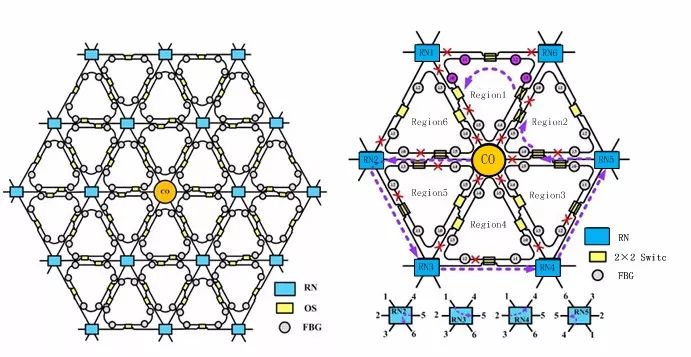Compared to traditional sensors, fiber optic sensors are non-electrical, resistant to electromagnetic interference, electrically insulated, corrosion-resistant, intrinsically safe, capable of multi-parameter measurement (temperature, stress, vibration, displacement, rotation, electromagnetic fields, chemical quantities, and biological quantities), highly sensitive, lightweight, compact, and can be embedded in objects. The fiber optic sensing network is a sensing network composed of various discrete sensing units and distributed sensing units arranged in a specific topological structure, characterized by large capacity, multiple parameters, complex topological structure, and high data processing requirements. The fiber optic sensing network is a trend and requirement for the development of fiber optic sensing technology, with broad applications in aerospace, power electronics, civil engineering, and safety monitoring, indicating a significant social demand and vast application prospects.

Fiber Optic Sensing Network
The fiber optic sensing network can be broadly defined as: a set of two or more fiber optic sensors multiplexed together, deployed within or very close to the measured object, measuring various performance parameters of the measured object. Depending on the types of sensing units, fiber optic sensing networks can be roughly divided into discrete fiber optic sensing networks and distributed fiber optic sensing networks.
Discrete Fiber Optic Sensing Network
In discrete fiber optic sensing networks, fiber optic sensing units are connected in series or parallel according to a certain spatial distribution pattern or other topological structures. Based on different modulation signal carriers, discrete fiber optic sensing units can be classified into five types: intensity modulation, frequency modulation, wavelength modulation, phase modulation, and polarization modulation. The most commonly used fiber optic sensing units are phase modulation type and wavelength modulation type.
Commonly used phase modulation type sensing units in discrete sensing units are constructed using interference principles, with specific structures including fiber Fabry-Perot (F-P) type, fiber Mach-Zehnder interferometric type, fiber Michelson interferometric type, and fiber Sagnac interferometric type. The sensing information is encoded in the interference phase, and changes in phase lead to changes in output light intensity, thus modulating the interference output light intensity. The fiber F-P type sensing unit utilizes the length of the F-P cavity to carry sensing information, achieving the goal of phase modulation. Due to its simple structure and stable interference signals, the fiber F-P type sensing unit is widely used for sensing parameters such as strain, temperature, pressure, and refractive index.
The typical representative of wavelength modulation type discrete sensing units is the fiber Bragg grating (FBG), which modulates the sensing information at the central wavelength. By monitoring the shift in the reflected wavelength of the FBG, changes in external parameters can be measured, and its detection ability is unaffected by fluctuations in light source power, fiber bending losses, aging of detectors, and other factors.
Distributed Fiber Optic Sensing Network
Distributed fiber optic sensing units mainly fall into three categories: distributed fiber optic sensing units based on optical time domain reflectometer (OTDR) technology, distributed fiber optic sensing units based on optical frequency domain reflectometer (OFDR) technology, and distributed fiber optic sensing units based on long-distance interference technology.
Distributed sensing units using optical time domain reflectometry utilize optical pulses for detection. The backscattered light generated when optical pulses travel through the fiber includes Rayleigh scattering at the same wavelength as the excitation light, as well as inelastic scattering—Raman scattering and Brillouin scattering—at different wavelengths. These scattered signals carry sensing information from various positions along the fiber, and the size of the measured parameters is determined by analyzing changes in signal characteristics (light intensity, polarization state, frequency, etc.). The spatial position is determined by the echo time, and spatial resolution is determined by pulse width, thus obtaining the spatial distribution of the measured parameters.
Currently, various OTDR-based distributed fiber optic sensing units have been reported, including micro-bend sensing units based on spontaneous Raman scattering OTDR, Brillouin optical time domain reflectometer (BOTDR) sensing units, polarization-sensitive OTDR (P-OTDR) sensing units, phase-sensitive OTDR (phase-OTDR or Ф-OTDR) sensing units, sensing units based on stimulated Raman effect, and sensing units based on stimulated Brillouin effect.
OFDR is an emerging technology in distributed fiber optic sensing, employing optical heterodyne interference techniques. It utilizes a linear tunable light source, with reference light and sensing light from the fiber coherently forming beat frequencies, where different test distances in the sensing fiber correspond to different beat frequencies. Traditional OFDR technology is primarily applied in short-distance optical links and optical devices for high precision and high spatial resolution monitoring.
Distributed fiber optic sensing networks based on interference technology are mainly applied in perimeter security and monitoring of oil pipeline theft, utilizing various interferometric structures such as Mach-Zehnder, Sagnac, Michelson, and hybrid or modified optical path structures based on these. The principle involves measuring the time delay, frequency, and intensity characteristics of the interference signals of counter-propagating light to analyze the size and occurrence location of the measurements, achieving distributed measurement.

Diagram of New Fiber Grating Self-Healing Sensing Network Structure

Diagram of Hexagonal Fiber Optic Sensing Network Structure
Main Performance Indicators of Fiber Optic Sensing Networks
1
Resolution
The wavelength displacement resolution primarily depends on the wavelength detection technology or wavelength decoding system used in the sensing system and the system’s signal-to-noise ratio.